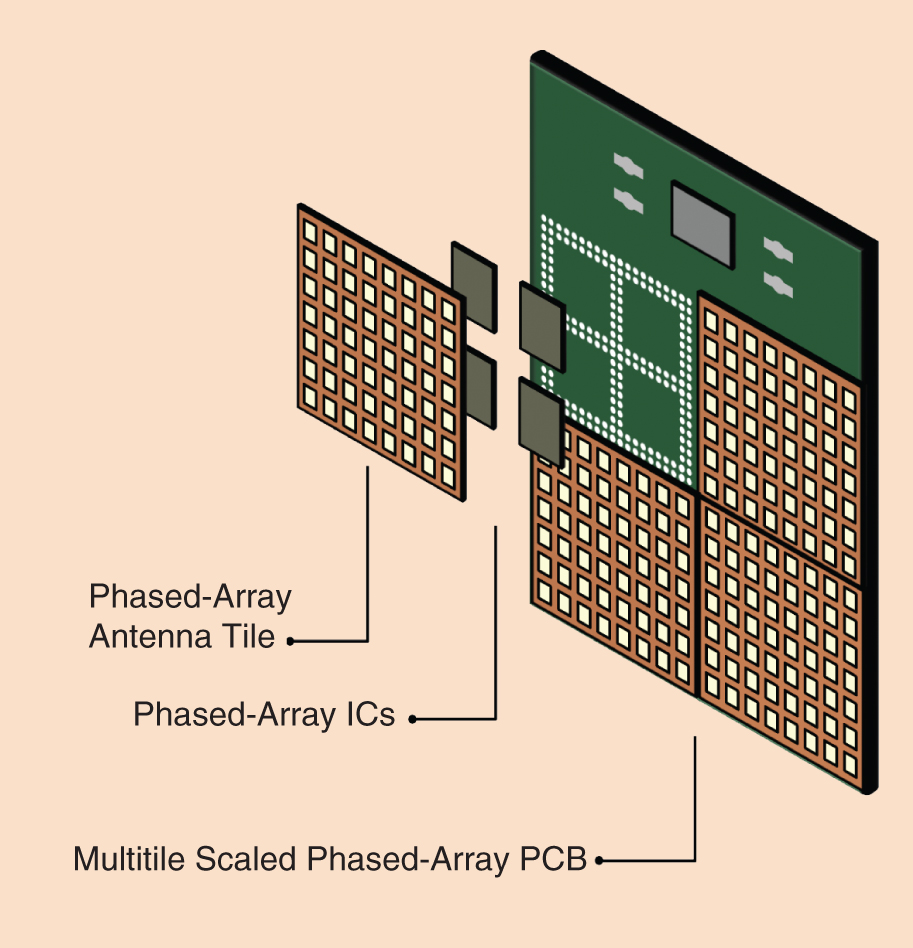Antenna Array Design Choices Characterization 1 1 Introduction Current cellular 4G networks face a multitude of challenges. Furthermore other challenges for the implementation of mmw cellular networks for example blockage.

Mimo And Phased Array Antennas For 5g
Developments in beamforming RFICs as well as antenna materials and fabrication techniques has laid the ground work for the implementation of 2D phased arrays for use in a cellular environment.

. In this paper a compact 1 6 antenna array is designed at 28 GHz millimeter wave frequency application with 21 VSWR. Zhang J Qiang X et al. As there has been an explosive increase in wireless data traffic mmw communication has become one of the most attractive techniques in the 5G mobile communications systems.
To be able to have one main beam without significant side lobes distance between array elements should be half-lambda which means half of the wavelength. The simulation results indicate that while there always exists a non-trivial gain. However the design of large active antenna arrays and radio access in the millimeter-wave bands is facing difficulties due to limitations dictated by physics.
This paper presents a design of multiple input multiple output MIMO antenna array for 5G millimeter-wave mm-wave communication systems. The proposed design of millimeter-wave mm-Wave array antenna package with beam steering characteristic for the fifth-generation 5G mobile applications has 10-dB gain in the upper spherical space good directivity and efficiency which is suitable for 5G mobile communications. The novelty of this work lies in finding out the gaps and challenges in the design of microstrip arrays and suggesting a suitable antenna structure for millimeter wave communication from the comparative study of performance.
In this article we discuss the issues involved in the design of antenna array architecture for future 5G mmw systems in which the antenna elements can be deployed in the shapes of a cross circle or hexagon in addition to the conventional rectangle. Antennas for 5G applications make use of the shorter element sizes at high. In this paper we will overview some of the challenges facing millimeter-wave antenna systems in 5G and NR.
Considering the drawbacks of working at the Ka band frequencies discussed in Section 1 we employed the microstrip antennas for this prototype study because the manufacturing process for microstrip type antenna with the help of modem-printed circuit technology adapted to testing and constructing purposes is simpler less expensive and. Even though the launch of 5G systems is just around the corner there are a plethora of challenges and outstanding issues that are yet to be resolved. Zhang 5G millimeter-wave antenna array.
Array with new materials. Soaring demand for mobile high resolution multimedia applications brings these networks ever closer to their practical limits. The purpose of this paper is to examine some these challenges from the point of view of antenna design for 5G.
Although mmw communication systems have been successfully applied to indoor. The scope of this Special Issue focuses on technical topics in mmWave antennas that may address but are not limited to the topics below. 5G millimeter-wave antenna array.
Hu et al the authors present a high gain millimeter-wave Low-Temperature Cofired Ceramic microstrip antenna array having a compact simple and low-profile structure. To sustain with this extensive global challenges use of antenna array is essential at the base station and cell site which will overcome the problems of large size hardware constraints and path loss because of very small wavelength associated with it. In addition in order to guarantee effective coverage of mmw communication systems possible solutions such as distributed antenna systems and cooperative multi-hop relaying are discussed together with the design of mmw antenna arrays.
1MA276_2e Rohde Schwarz Millimeter-Wave Beamforming. High-frequency surface-wave radar HFSWR is widely used in vessel and. Some Challenges in Millimeter Wave Antenna Designs for 5G.
Microstrip Antenna Array Design. Significant level of interference. 5G mm-Wave USB dongle.
Antenna Array Design Choices Characterization Rohde Schwarz The next big thing advances in 5G millimeter wave antennas Benchmark. There are challenges in choosing an appropriate substrate and challenges in its fabrication but overcoming these challenges can be key to successfully reducing losses. FR4 PCB grid array antenna for millimeter-wave 5G mobile communications Proc.
New antenna structures MIMO massive-MIMO beamformingbeam steering adaptive array and array with reconfigurable feed network. Each antenna array consists of four elements which are arranged in an even manner while two arrays are then assembled with a. This new requirement brings limits in radiating element size it.
End-fire phased array 5G antenna design using leaf- sh aped bow-tie elements for 2838 GHz MIMO applications Proc. 5G millimeter-wave antenna array. Low-cost and low-loss phase shifters for scanning array antennas.
As there has been an explosive increase in wireless data traffic mmw communication has become one of the most. In this article the issues involved in the design of antenna array architecture for future 5G mmw systems in which the antenna elements can be deployed in the shapes of a cross circle or hexagon are discussed in addition to the conventional rectangle. This paper presents a design of multiple input.
Implementation of 5G mm-Wave technology requires a lot of significant changes in antenna design engineers work. Challenges faced by the millimeter wave communication in. Moving to antenna arrays instead of single elements allows beamforming and beam steering.
Design and challenges IEEE Wireless communications 24 no. Although mmw communication systems have been successfully applied to indoor scenarios various external. Antennas fabricated with new.
Frequency range 1 for sub 6 GHz bands communication and frequency range 2 for communication at the millimeter mm wave Sub-6 GHz Antenna Design Approach 5G antennas can be divided into two categories by their operating frequency. Wideband and dual. In Millimeter-Wave Microstrip Antenna Array Design and an Adaptive Algorithm for Future 5G Wireless Communication Systems by C-N.
The design and testing of the 5G communication system hinge on the Two frequency ranges are of most interest. 5G NR millimeter wave systems are being implemented for commercial applications and show both the promise and challenges of 5G high data rate applications. Antennas specification becomes more and more complicated.
The proposed MIMO configuration consists of a two antenna arrays combination. Raj Mittra 12.

Pdf Multiband Millimeter Wave Antenna Array For 5g Communication
A Millimeter Wave Wafer Scale Phased Array With On Chip Antennas Download Scientific Diagram

Pdf High Performance 5g Millimeter Wave Antenna Array For 37 40 Ghz Mobile Application

5g Infrastructure Rf Solutions

Example Use Case Scenarios For Millimeter Wave 5g Phased Arrays Download Scientific Diagram
A Simplified Block Diagram Of A Large Scale Antenna Array Based Mmwave Download Scientific Diagram
What Is New Gt In Packaging 5g And Mm Wave Packaging News Center

Gapwaves Launches New 5g Mmwave Phased Array Antenna Gapwaves Ab
0 comments
Post a Comment